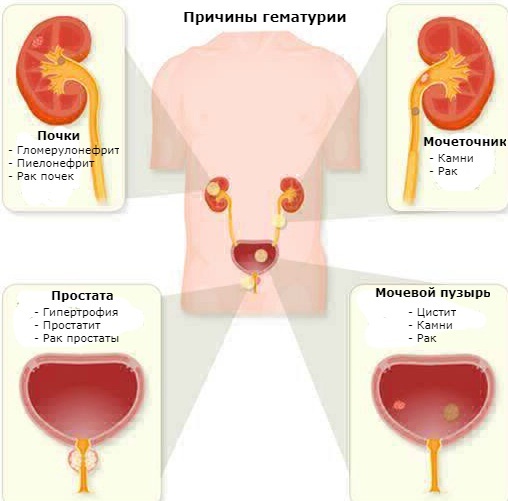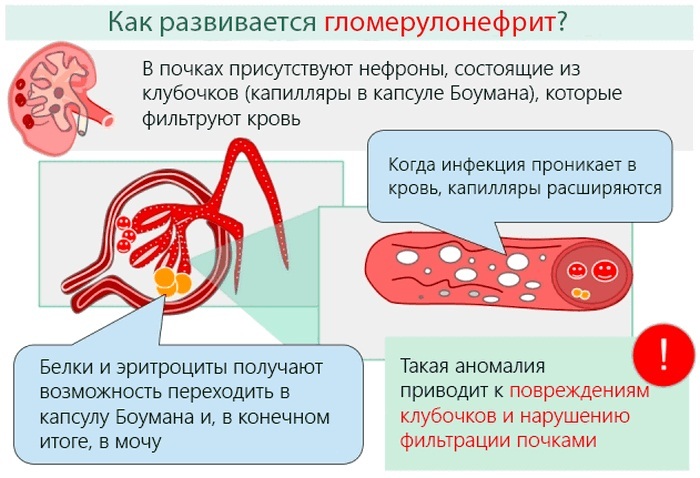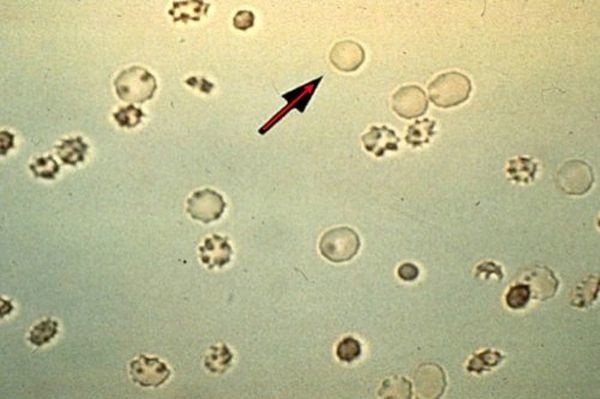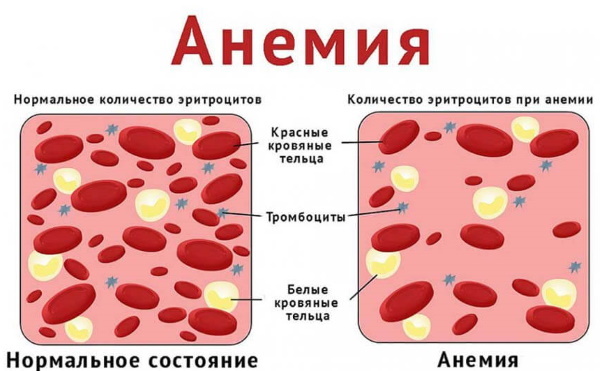Unchanged and modified erythrocytes are present in many biological fluids of the human body. However, often the first type of cells appears in the urine, which makes patients worry and look for the cause of such disorders. In some cases, anxiety is unfounded, but quite often the symptom speaks of the development of various diseases that are at an initial stage.
Record content:
- 1 Functions in the body
- 2 How and under what conditions are produced
- 3 Table indicators are normal
- 4 Increase symptoms
- 5 Reasons for the increase
- 6 Indications for research
- 7 How is it determined
- 8 Preparation and analysis
- 9 Decoding the results
- 10 When to see a doctor
-
11 How to bounce back
- 11.1 Medications
- 11.2 Traditional methods
- 11.3 Other methods
- 12 Possible complications
- 13 Video about hematuria
Functions in the body
Red blood cells are rather small, round biconcave cells, also called red blood cells. There are 2 types of these cells in the body - modified and unchanged.
The former almost always arise as a result of some kind of disease, do not contain hemoglobin and are ring-shaped. They are not present in the systemic circulation. In most cases, they appear in biological fluids, have a pale color.
The unchanged red cells have the correct shape and contain hemoglobin, are painted in a bright red color. They are present in human blood and, with various abnormalities, can appear in other biological fluids.
It should be noted that in the human body, erythrocytes occupy almost 25% of the total volume of all cells.

Red blood cells perform several important functions in the human body:
- They supply hemoglobin and oxygen to the tissues, due to which metabolism is carried out.
- They help to transport carbon dioxide from cells, which facilitates gas exchange and accelerates metabolism.
- They normalize the acid-base balance in the body, which prevents various diseases associated with its violation.
- They stimulate the formation of important enzymes and other substances in the body that ensure normal metabolic processes.
- Relieve symptoms of intoxication and prevent the re-development of the condition.
- They help transport nutrients from food to the cells.
Due to the complex action of cells, many processes are carried out in the human body, which is very important for the normal functioning of internal organs.
How and under what conditions are produced
Unchanged red blood cells in the urine cannot appear without the production of cells in the body. Every few seconds, the red bone marrow produces more than 2 million. erythrocytes. Normally, they are in the systemic circulation for 100-120 days, after which they are absorbed by macrophages, and newly formed cells enter the blood.
Red blood cells are formed in the red bone marrow of large bones, such as the pelvic, vertebrates, ribs, and even the bones of the skull. This process requires the normal functioning of the organ.
It should be noted that the formation of cells occurs in several stages, each of which follows from the previous one:
- The initial stage is accompanied by the formation of erythroblasts. These cells outwardly resemble erythrocytes, but are large in size, as well as some differences in the membrane.
- Erythroblasts form pronormocytes, which are smaller in size, but also do not look like full-fledged red blood cells.
- Basophilic normocyte is the next stage of cell formation. These cells already have an irregular pinkish color.
- A polychromatophilic normocyte has a high concentration of hemoglobin.
- The oxyphilic normocyte is more reminiscent of an erythrocyte in shape and size, it has a bright pink color.

- The reticulocyte is the precursor of a full-fledged erythrocyte, but has a different color.
- A mature red blood cell is called a normocyte. It is these cells that enter the systemic circulation and perform various functions.
After all functions have been completed, the absorption of cells occurs in the liver and spleen. This process is normal, but in various diseases it can be disrupted.
Table indicators are normal
Normally, for each age group, the number of red blood cells in the urine is slightly different. A deviation from the norm is considered a disorder that requires treatment.
| Age group | The rate of erythrocytes in urine |
| Newborns and children under 3 years of age | 2 to 5 cells per field of view |
| Patients from preschool and school age | No more than 4 cells in the field of view |
| Men | Up to 1 unit per field of view |
| Women | No more than 3 units in the field of view |
The absence of cells in the test material is not considered a deviation, but exceeding the permissible norm is a reason for visiting a doctor.
Increase symptoms
Unchanged red blood cells in the urine may appear against the background of the absolute health of a child or adult. However, with the progression of the condition, the violation is necessarily manifested by various symptoms, the severity of which depends on the body and the characteristics of the course of the pathological process.
Outwardly, the violation can be manifested by pallor of the skin, dark circles under the eyes, as well as skin moisture, which is associated with increased work of the sweat glands. In addition, hematomas may appear on the patient's body even with light pressure or bruising. This indicates a violation on the part of the vessels, provoking capillary fragility and hemorrhage under the skin.
In addition, patients experience weakness and fatigue. Depending on the cause of the appearance of red blood cells in the urine, the patient may talk about pain in the abdomen, as well as the kidney area.
In medicine, the appearance of unchanged red blood cells in urine is called hematuria.. It can be accompanied by pain in the bladder area as well as discomfort when urinating.
Additionally, in many patients, the body temperature rises, pains in the heart area, and a decrease in blood pressure indicators are possible. If the appearance of cells in urine is associated with pathologies of the reproductive system, pain appears in the lower abdomen, which intensifies when urinating. This symptom is typical for men suffering from prostatitis and other diseases.
In women, at the same time, the menstrual cycle is disrupted, the appearance of pathological discharge from the vagina is possible. Additionally, almost all patients with hematuria have weakness, fatigue, and headache. The condition of the child with such a violation usually does not worsen.
A slight decrease in physical activity and an increase in body temperature are possible. Only with a prolonged course of the disorder does the child develop general symptoms in the form of weakness, dizziness and impaired appetite.
The nature of the symptoms and the severity of manifestations depends on the cause that provoked hematuria.
Reasons for the increase
Unchanged or altered red blood cells can appear in the urine of patients for various reasons.
The most common of them are the following:
- Kidney and bladder injuries of varying severity.
- Contusions of internal organs, provoking a deterioration in the functioning of the liver, kidneys, digestive tract.
- Diseases of the genitourinary system in patients of different ages. Erythrocytes in urine can appear with pyelonephritis, glomerulonephritis, urethritis, cystitis, prostatitis, prostate adenoma. In women, the symptom may be associated with endometritis, endometriosis, fibroids, cycle disorders, inflammatory pathologies of the appendages.

- Pathologies of the red bone marrow, in which the process of production of red blood cells is disrupted, as well as the entry of immature cells into the systemic circulation.
- Malignant neoplasms of internal organs.
- Diseases of the blood, accompanied by a violation of its coagulability.
- Infectious pathologies accompanied by a febrile state.
- Damage to the kidneys with a tubercle bacillus, rupture of the ureters, bladder.
- Severe urolithiasis.
- Overheating of the body as a result of prolonged exposure to open sunlight, in a bath or sauna.
- Stressful situations in which all metabolic processes in the body are disrupted.
- Improper nutrition with a large amount of spicy, fatty and sour in the diet, as well as the abuse of alcoholic beverages on an ongoing basis.
- Excessive and constant physical activity.
Various factors lead to the appearance of cells in the blood. Their number also depends on the pathology and the degree of its neglect.
Indications for research
In some cases, the appearance of cells in the urine is temporary and does not require treatment. But more often the condition requires diagnosis and treatment in order to prevent complications.
The main indications for research:
- A large number of cells in the urine, an increase in the rate as the disease progresses.
- Severe pain in the kidneys or lower abdomen.
- Foreign impurities in urine in the form of pus, sand.
- Deterioration of the general condition.
- Fever.
- The appearance of complications from the internal organs.
These indications are considered a reason for an immediate visit to the doctor. As a rule, it is recommended to contact a therapist who will order the study.
How is it determined
Unchanged red blood cells in urine are determined by clinical examination of urine in a laboratory setting. Other methods are not used because general analysis is the most informative and reliable.

If necessary, a clinical blood test is prescribed, which allows you to get a complete picture of the general condition of the patient and determine the need for other studies.
Preparation and analysis
Special preparation for the collection of biological material is not required, but doctors recommend following some rules. Do not drink alcohol 10-14 days before urine collection. 3-5 days before that, it is better to refuse sour, salty, spicy foods, which can negatively affect the condition of the kidneys, and also distort the diagnostic result.
It is important not to overwork yourself and avoid stressful situations. The collection of material is carried out necessarily in the morning when you first visit the toilet and after washing the genitals with warm water and soap.
Experts recommend not collecting urine for the first 2 seconds after the start of urination, but start collecting after 2 seconds. The urine container must be dry and clean. It is better to give preference to sterile pharmacy jars with a lid, which are designed for the material.
After collection, urine should be sent immediately to the laboratory. But you can store it in the refrigerator if necessary. Doctors recommend examining the material directly on the day of collection, which makes the result more accurate.
In laboratory conditions, urine is examined under a microscope, the number of abnormal cells and other components normally present in the material is counted.
Decoding the results
The result of the study can be obtained the very next day after the delivery of the material.
Normally, it contains the following parameters:
- The volume of the test material, which depends on how much the patient has collected urine.
- The color should normally be straw yellow, but with a significant number of red blood cells, it can be pink or even red. In addition, normal urine is clear.
- The density is normally between 1002 and 1025. With deviations, the indicator can change in one direction or another.
- Normally, there is no glucose in the analysis.
- The amount of protein normally does not exceed 0.03 g / l.
- Ketone bodies and bilirubin are normally absent. With pathologies, it can appear in different quantities.
- Erythrocytes unchanged normally depend on age. For children under one year old - no more than 5 cells in the field of view, children of preschool and school age - up to 4 cells in the field of view, women - up to 3 units in the field of view, men - up to 1 cell in the field of view. With an increase in this indicator, we can talk about hematuria of varying degrees of neglect.
- The amount of squamous epithelium is insignificant or moderate. If the analysis indicates “a lot,” the patient is most likely to have a medical condition.
- Leukocytes are normally 1-4 units per field of view. An increase in the level indicates the development of inflammation.
- Modified red blood cells should not be present in the material.
- Bacteria, fungi, salts, mucus, columnar epithelium are normally absent as a result.
When studying the result, it is worth relying on normal indicators. Their deviation speaks of diseases.
When to see a doctor
An independent study of the results of the study helps to detect deviations, if the patient is approximately aware of the norm for his age. If any item does not correspond to the norm, but show significantly or slightly increased, it is worth visiting a therapist.
The doctor will conduct an examination and prescribe additional diagnostics in order to identify the cause of the deviation. Usually consultation of a urologist, gynecologist, cardiologist, gastroenterologist, endocrinologist is required.
How to bounce back
Unchanged red blood cells in the urine appear as a result of various factors. However, in most cases, the violation is associated with pathologies of the genitourinary system. Treatment is aimed at eliminating the underlying disease.
Medications
Various medications are used in the treatment, which depends on the specific disease, the presence of complications.
The following groups of funds are considered the most effective:
-
Ibuprofen Is a non-steroidal anti-inflammatory medication that is used to relieve pain, relieve symptoms of inflammation and lower body temperature. The patient is prescribed from 1 to 3 tablets per day, the course of treatment lasts up to 7 days. The drug effectively eliminates severe manifestations and significantly alleviates the patient's condition.

- Spazmalgon - a drug that has anesthetic and antispasmodic effects. It is used for cystitis and other pathologies of the genitourinary system, helps to alleviate the condition, as well as urination. This allows you to remove from the organs pathogenic microorganisms that lead to the appearance of red blood cells in the urine. Take tablets 2 times a day, 1 piece, repeat the reception for 5-8 days in a row.
- Azithromycin - a broad-spectrum antibiotic that relieves the patient's condition when detecting infectious, bacterial diseases of the bladder, kidneys, urethra, and other internal organs. Tablets are taken orally 1 piece 2 times a day for 3-6 days, depending on the severity of symptoms.
- Urolesan - a herbal remedy in the form of capsules, which is actively used to eliminate microbes from the organs of the urinary system. Capsules are taken 3 times a day, 1 piece for 10-20 days, depending on the severity of symptoms.
- Monural - a very effective antimicrobial medication in powder form, which is often prescribed for hematuria as a result of kidney or bladder damage. The tool is taken once in the amount of 1 sachet. The powder is dissolved in 100-150 ml of water, the solution is taken orally. If necessary, the reception is repeated after 5-7 days.
- Dicinon - an agent for stopping bleeding, which is prescribed in the case when a large number of red blood cells are found in the urine on an ongoing basis. In this case, the drug is used in courses of 3-7 days, daily the patient is injected with 2 ml of the drug intramuscularly 2-3 times a day. This helps to stop bleeding, which is associated, for example, with damage to the bladder wall by a stone.
- No-shpa - an antispasmodic medication that is used for damage to the kidneys, bladder, liver or urethra. Helps relieve cramping and pain. Tablets are taken 3 times a day, 1-2 pieces for 10 days.
-
Cycloferon - an antiviral medication that is prescribed to patients in the case when the appearance of red blood cells in the urine is associated with a protracted course of a viral disease. The patient is injected intramuscularly with 2 ml of the drug per day for 10 days. In some cases, an individual scheme is used, involving breaks between injections.

The treatment regimen in each case may differ, depending on the disease and possible complications. It is important not to self-medicate as the risk of complications is increased.
Traditional methods
Folk remedies do not help to completely cure the patient, but they can significantly alleviate his condition.
A decoction based on nettle leaves is considered one of the most effective natural remedies for stopping bleeding. For 500 ml of water, you need to take 5 g of dry leaves of the plant, cook for 3 minutes, leave for 1 hour to infuse. After that, the filtered broth is taken orally, 50 ml 2 times a day for 5 days.
Douching with calendula decoction is considered another effective remedy. This method can only be used by women when bleeding is associated with pathologies of the reproductive system of an inflammatory nature.
For 1 liter of water, take 20 g of dried plant flowers, cook for 10 minutes. After cooling, filter the product and use it in the evening for douching. Repeat the procedure for 10 consecutive days.
Alternative methods can worsen the course of the underlying disease, so their use should be agreed with the doctor.
It is strictly forbidden to visit saunas, baths, and also take hot baths when red blood cells appear in the urine.
Other methods
Among the additional methods of therapy, physiotherapy and surgery can be distinguished. Physiotherapy is used for hematuria associated with kidney damage. Electrophoresis is considered a popular and effective procedure. At the same time, special electrodes are applied to the kidney area, which act on the organ and stimulate tissue regeneration.
The course consists of 10-15 procedures with a frequency of 1 time in 3 days. The manipulation lasts up to 30 minutes.
If the ureter ruptures, bladder tumors, internal bleeding or large kidney stones are detected, surgery is performed. The method is most effective in this case. Features of the operation and the recovery period depend on the disease.
Today, the operation can be carried out in an open way or use endoscopic instruments and carry out a minimally invasive procedure. Each case requires an individual approach.
Possible complications
Lack of therapy will certainly lead to various complications, so you should not postpone your visit to the doctor.
The most common consequences:
- Aggravation of the symptoms of the underlying disease.
- Massive blood loss.
- Anemia due to loss of large amounts of blood.

- The spread of the inflammatory process.
- Damage to the kidneys or bladder from the movement of calculi.
- Germination of a tumor into closely located organs, if the cause is an oncological disease.
Complications also depend on the underlying disease that triggered the hematuria.
Unchanged and altered red blood cells can appear in the urine of a child and an adult. The reasons for this disorder are different; in some cases, treatment is not required. However, more often the patient needs to see a doctor immediately to prevent complications.
Video about hematuria
Doctor about hematuria:



